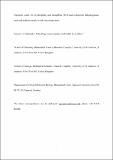Files in this item
Transition states for psychrophilic and mesophilic (R)-3-hydroxybutyrate dehydrogenase-catalyzed hydride transfer at sub-zero temperatures
Item metadata
| dc.contributor.author | Machado, Teresa F. G. | |
| dc.contributor.author | Purg, Miha | |
| dc.contributor.author | Åqvist, Johan | |
| dc.contributor.author | da Silva, Rafael G. | |
| dc.date.accessioned | 2022-06-29T23:38:39Z | |
| dc.date.available | 2022-06-29T23:38:39Z | |
| dc.date.issued | 2021-07-13 | |
| dc.identifier | 274948811 | |
| dc.identifier | 22e504d1-bb81-4cdb-8475-3ae79968f593 | |
| dc.identifier | 000674253400004 | |
| dc.identifier | 85110985944 | |
| dc.identifier.citation | Machado , T F G , Purg , M , Åqvist , J & da Silva , R G 2021 , ' Transition states for psychrophilic and mesophilic (R)-3-hydroxybutyrate dehydrogenase-catalyzed hydride transfer at sub-zero temperatures ' , Biochemistry , vol. 60 , no. 27 , pp. 2186–2194 . https://doi.org/10.1021/acs.biochem.1c00322 | en |
| dc.identifier.issn | 0006-2960 | |
| dc.identifier.other | RIS: urn:983598083E268C2A112CE1DD59EE034D | |
| dc.identifier.other | ORCID: /0000-0002-1308-8190/work/96817607 | |
| dc.identifier.uri | https://hdl.handle.net/10023/25583 | |
| dc.description | This work was supported by the Engineering and Physical Sciences Research Council (EPSRC) (Grant EP/L016419/1) via a CRITICAT Centre for Doctoral Training studentship to T.F.G.M., and by the Swedish Research Council and KAW Foundation grants to J.Å. | en |
| dc.description.abstract | (R)-3-Hydroxybutyrate dehydrogenase (HBDH) catalyzes the NADH-dependent reduction of 3-oxocarboxylates to (R)-3-hydroxycarboxylates. The active sites of a pair of cold- and warm-adapted HBDHs are identical except for a single residue, yet kinetics evaluated at −5, 0, and 5 °C show a much higher steady-state rate constant (kcat) for the cold-adapted than for the warm-adapted HBDH. Intriguingly, single-turnover rate constants (kSTO) are strikingly similar between the two orthologues. Psychrophilic HBDH primary deuterium kinetic isotope effects on kcat (Dkcat) and kSTO (DkSTO) decrease at lower temperatures, suggesting more efficient hydride transfer relative to other steps as the temperature decreases. However, mesophilic HBDH Dkcat and DkSTO are generally temperature-independent. The DkSTO data allowed calculation of intrinsic primary deuterium kinetic isotope effects. Intrinsic isotope effects of 4.2 and 3.9 for cold- and warm-adapted HBDH, respectively, at 5 °C, supported by quantum mechanics/molecular mechanics calculations, point to a late transition state for both orthologues. Conversely, intrinsic isotope effects of 5.7 and 3.1 for cold- and warm-adapted HBDH, respectively, at −5 °C indicate the transition state becomes nearly symmetric for the psychrophilic enzyme, but more asymmetric for the mesophilic enzyme. His-to-Asn and Asn-to-His mutations in the psychrophilic and mesophilic HBDH active sites, respectively, swap the single active-site position where these orthologues diverge. At 5 °C, the His-to-Asn mutation in psychrophilic HBDH decreases Dkcat to 3.1, suggesting a decrease in transition-state symmetry, while the His-to-Asn mutation in mesophilic HBDH increases Dkcat to 4.4, indicating an increase in transition-state symmetry. Hence, temperature adaptation and a single divergent active-site residue may influence transition-state geometry in HBDHs. | |
| dc.format.extent | 1282565 | |
| dc.language.iso | eng | |
| dc.relation.ispartof | Biochemistry | en |
| dc.subject | Hydride transfer | en |
| dc.subject | Redox reactions | en |
| dc.subject | Hydrogen isotopes | en |
| dc.subject | QD Chemistry | en |
| dc.subject | DAS | en |
| dc.subject.lcc | QD | en |
| dc.title | Transition states for psychrophilic and mesophilic (R)-3-hydroxybutyrate dehydrogenase-catalyzed hydride transfer at sub-zero temperatures | en |
| dc.type | Journal article | en |
| dc.contributor.sponsor | EPSRC | en |
| dc.contributor.institution | University of St Andrews. Biomedical Sciences Research Complex | en |
| dc.contributor.institution | University of St Andrews. School of Biology | en |
| dc.identifier.doi | https://doi.org/10.1021/acs.biochem.1c00322 | |
| dc.description.status | Peer reviewed | en |
| dc.date.embargoedUntil | 2022-06-30 | |
| dc.identifier.grantnumber | EP/L016419/1 | en |
This item appears in the following Collection(s)
Items in the St Andrews Research Repository are protected by copyright, with all rights reserved, unless otherwise indicated.

